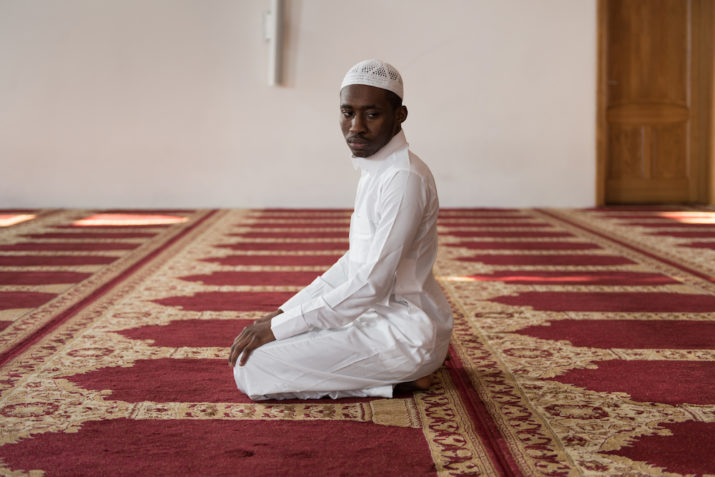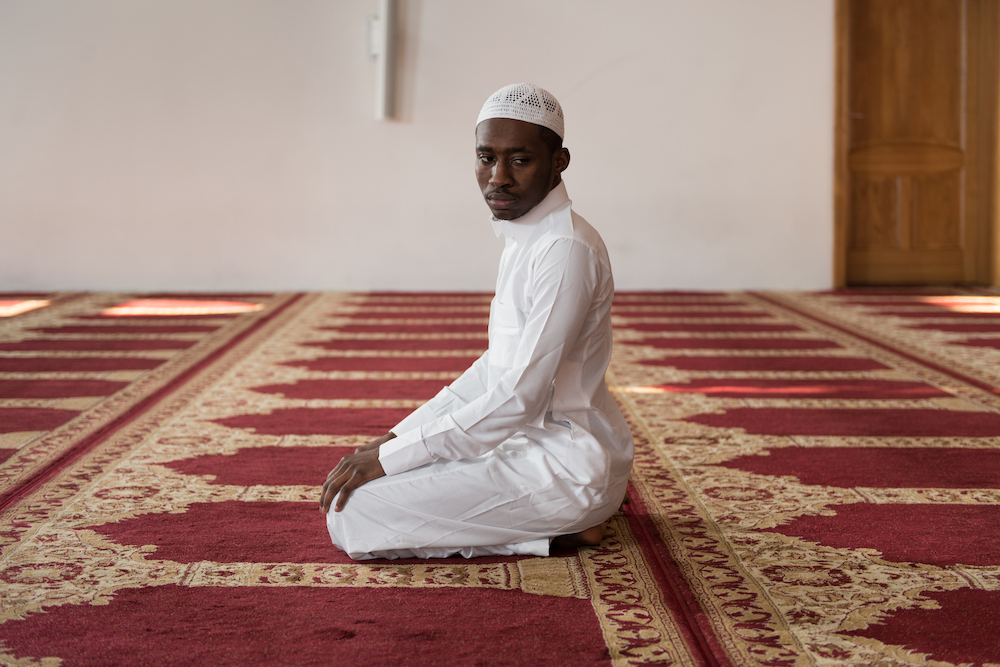

This is part of our special feature on Race and Racism in Europe: The Urgency of Now.
The last century has seen growing ethnic diversity in France as immigrants from former French colonies and economic migrants from all over Europe settled, made homes, became citizens, and built lives across generations. As these minority populations have grown, diverse cultural practices and customs have increasingly entered the public sphere, forcing questions of integration, belonging, and ethnic difference into public debate and onto policy agendas. Publics often experience these growing differences viscerally, perceiving affective cues in everyday life, and reacting to and making sense of these impressions through shared discourse and prior frames of knowledge. This blending of sensory perception, discourse, and ideology is accompanied by a concomitant blurring of social categories: race, religion, ethnicity, culture—all lose their sharp edges as concepts when we experience them as lived habits and everyday norms.
In France, as well as in other European countries in recent years, this blurring has often taken shape in the form of ongoing, heated debates on the subject of Islam in the West. Discussions have centered on supposed “hypervisibility” of Muslims, the mosque minaret debates, cartoon depictions of the Prophet Muhammed, access to prayer space and, prominently, the act of veiling by Muslim women. Here, difference centers seemingly on religion, but critiques levied against the presumed challenges Muslims face integrating into society more often than not smuggle notions of race and culture into their arguments. These in turn often rely on normed and unexamined understandings of everyday behaviors—an extension of what Helen Ngo has called “racist habits” (Ngo 2016).
The tendency to conceptualize Islamo-racial difference through visuality—based on the elemental premise that some groups of people look differently from other groups of people—obscures the fact that the perception of difference extends far beyond our eyes and routinely incorporates knowledge and expectations from domains of hearing, smell, touch, and taste as well. It also obscures the critical role these internalized norms play, not only at the individual level, but also collectively, going so far as to structure public discourse, political decision-making, and law. Yet, habitual conduct and ingrained processes of this sensory nature are often hard to parse, particularly in moments of contentious politics or violence, when emotions are likely to run high. Instead, seemingly banal and quotidian experiences offer a ground-up perspective of how particular sensory practices shape politics of race and belonging. In what follows, I sketch how this unfolds in a single sensory register, namely hearing and sound. While much has been written about Islam’s visuality in France, few have tuned their antennae to other forms of collective and bodily presence. Paying attention to public religious sound in France allows us to understand underlying mechanisms at play in some political arguments and how diverse strategic interests align around Othering practices to form unusual political coalitions. Moving past superficial, visual differences also reveals in stark relief the extent to which the concept of “race” is culturally constructed.
It is often claimed that the Muslim call to prayer, or adhan, is not broadcasted from minarets in France because French conceptions of secularism, or laïcité, protect public space, schools, and the state, from religion. This notion has been stated with such confidence as to make further examination of the adhan in France seem unnecessary or even incendiary. Yet, such an explanation cannot provide an understanding of why Muslims in France—proportionately the largest Muslim community in Europe—have not pressed this silencing as an issue of religious freedom as they have in England, the United States, Germany, and Sweden. How, precisely, is the suppression of a Muslim sound reconciled with the common presence of church bells ringing out Christian convictions, and what role does the adhan, and its effective silencing, play in French politics of belonging? How do race and racialized perception interact with these religious sounds, and in what ways are these sounds significant in French society? We have a limited understanding of how the adhan is governed and what power structures uphold a public soundscape’s aesthetic norms. Everyday sensory understandings and perceptions shape, change, and constrain politics, society, and law, with wide-ranging effects on belonging, citizenship, ethnic conflict, and, not least, understandings of race. I explore such questions in what follows, demonstrating how sensory insights are racialized, how they operate to conflate religion and race, and how they generate physical and psychological forms of knowledge and habits that produce society in particular ways.
In a recent piece in a special issue of French Politics (2020), I examined these topics by juxtaposing the familiar toll of ringing church bells in France with the comparatively unusual sound of the muezzin’s call to prayer. I found that habituated listening practices among majority French—their acculturated ability to tune out church bells and their simultaneous hypersensitivity to the Muslim adhan—impacted the way constitutional laws are interpreted at the local level in municipalities. Majority French knowledge of the Muslim call to prayer, in turn, was influenced largely by public discourse, since the prayer call rarely resounds in French public space. These sensory practices and modes of perception resulted in unequal access to public space and rights as citizens for French Muslims.
This process took shape in the following way: the French Constitution protects religious sound in Article 27 of the 1905 law, upholding the principle that citizens may express their religious convictions as long as it does not disrupt the public order. The Constitution, however, accords municipalities control over the regulation of sound in their respective territories, such that the law may accommodate local preference regarding the aesthetic texture of tranquilité and order. Church bells generally ring throughout France without constraint; lawsuits or noise complaints against bells are infrequent despite the bells’ patently religious nature and the prominence of their sound in public space, and despite the French public’s vocal commitment to laïcité and the limited role that religion plays in the lives of French citizens. (In a 2009 Gallup poll, 69 percent of French citizens claimed religion was not important in their daily life.) Thus, despite waning religiosity and widespread support for policies that limit religion in the public sphere, church bells seem to escape notice. This may be explained, I argue, because mainstream French perceptions of “silence,” incorporate ringing church bells. Put differently, many Catholics and secular French have stopped hearing Church bells; or, if they do hear them, mechanically-speaking, the bells no longer contain sufficient substantive meaning to draw attention to themselves.
This perception of silence, however, does not extend to Islamic sounds. Mainstream public opinion in France remains staunchly opposed to the open-air broadcast of the Islamic call to prayer. The political right has been the most outspoken against the adhan, but the idea of an Islamic call vibrating through French airwaves has long met with widespread disapproval: a 1989 IFOP survey of French opinion found that more than one third of French people are opposed to the construction of mosques because of their prominent visibility (the height of the minaret) and the supposed noise disturbance of the call to prayer.[i] A follow-up survey five years later found that, while negative attitudes toward minaret heights had fallen in favor of people who characterized themselves as “indifferent,” opposition to the prayer call remained as solid as before.[ii] Former President Nicolas Sarkozy, capitalizing on this sentiment in 2010, and speaking on the topic of immigration, said “that there should be places of worship for Muslims is quite normal, there are more than 2,000. But in France, there is no minaret, there is no muezzin that makes the call to prayer,” adding that he hears his compatriots when they say, “we want to stay in France, the France that we love.”[iii]
The adhan, then, despite functioning comparably to church bells as a religious signal, is not protected as an expression of religious conviction under the 1905 laïc formulation because it fails to meet French aesthetic standards that comport with perceptions of tranquilité. Stripped of this constitutional protection, it falls into the category of “noise,” at which point it is governed on the basis of local environmental and loudspeaker laws. The technocratic regulation of the adhan as noise, coupled with public opposition, creates a scenario in which municipal power brokers thwart the intention of the national principle protecting the expression of religious conviction, as well as the mandate to treat recognized religions equally under the law.
As a result, most mosques across France eschew the public broadcast of the adhan, despite its central role in initiating the ritual prayer. Most resort to calling its verses exclusively inside the space of the mosque. The alteration of this Islamic practice to conform with French norms is akin to the “compromise” offered to Muslims in Creil who sparked the first veil controversy in 1989. These women were told they could continue to wear their foulard at school if they dropped it from their head to their shoulders while in the classroom (Jones 2009, 50). Dropping the headscarf to the shoulders, much like limiting the adhan to the inside of a mosque, erases cultural-religious rationales and histories undergirding the practices, altering their significance in the process and overwriting ways in which these embodied practices give rise to subjectivities. In so doing, it simultaneously removes the practice in question from the sphere of public debate.
In the context of the adhan, commonplace, aural understandings of tranquilité mute political debate on issues related to citizenship, belonging, and equal rights for French Muslims, transforming these into local-level questions of noise pollution. In a national context where Islam has for several decades now been extremely politicized, Muslims themselves are largely excluded from the conversation—both in terms of who among them is authorized to speak as “French,” and in terms of how they may present themselves through direct public action. The question of when and where and how Muslims are allowed to act out their own understandings of Europeanness in the public sphere is increasingly at issue (for a discussion of this in terms of visuality, see Jonker and Amiraux 2006).
Shared majority French perceptions of silence make possible a cognitive dissonance with political ramifications. It makes entitles church bell advocates to claim rights to religious expression under the 1905 law, even as it allows people opposed to noise pollution to claim the right to “tranquilité.” This cognitive frame, in which bells are not considered an interruption of silence, enables broad coalitions of the political Right and Christian conservatives, as well as the atheist, secular Left, thereby affectively unifying non-Muslim French in opposition to the adhan. Thus, embodied knowledge and sensory perception constitutes shared ground that may help explain the sometimes-odd political alliances that have formed in recent years. These collective understandings are triggered when political actors cite bodily, visceral events in political debates, relying on these to generate affective shortcuts that reference mainstream norms for their listening audience.
Grounds for objection to the Muslim prayer call are complex and may include noise concerns, the defense of secular space, xenophobia, tradition, and other subjective factors. Many of these concerns take shape via the sensory, affective, emotive, and discursive associations that these audial triggers carry with them. For example, one element that contributes to the negative reception of the adhan is the way the sound has often been associated with terrorism in popular media. French media treatment of the adhan largely falls into two categories—either it is referenced in a descriptive sense, often in the context of evoking “exotic” Oriental alterity, or it is cited in association with terror attacks and violence. Instances of such reporting range from news reports of the Charlie Hebdo shooters’ shouting “Allahu Akbar” as they entered the building, to Muslim protesters praying or chanting in streets,[iv] and to the cooptation of the phrase by non-Muslim French minors in Bezier who prank-called “Allahu Akbar” over the public announcement system on a train before threatening to kill the passengers in a fake terrorist attack.[v]
The metonymic identification of Muslim symbols with Otherness and terrorism has been pointed out by Alia Al-Saji, writing on the topic of veiling. Al-Saji notes how the relative intransigence of western representations of Islam, spanning from colonial times into the present, forces Muslims, and Muslim women in particular, into categories that have been scripted in advance (Al-Saji 2010). As a public sound, the adhan similarly falls into pre-scripted conceptual categories—not all of which pertain to religion. In other words, attending to sound and listening practices in this way reveals how the distinction between religion, politics, race, and ethnicity is not always clear—not only in terms of conceptual category, but also in terms of how these categories are constructed from the ground up. As Nilüfer Göle and others have noted, Islam in France is rarely controversial in terms of institutional or textualized forms of subjectivity; rather, social dispute is visceral and “carried by corporeal performances and self-presentations” (Göle 2002, 183). Habituated sensorial norms have long been essential to the construction of racialized differences, and these spill over into nearly every aspect of everyday life—as noted imperiously by Jacques Chirac in his now infamous 1991 comment about “le bruit et l’odeur” (the noise and the odor) produced by “foreigners” in France who profit from social security benefits.
As is clear from Chirac’s quote, in debates on Muslim belonging and proper boundaries of “Frenchness,” not just sound, but all the senses have been conscripted into political arguments. As such, a focus on sonic aspects of public space should not be heard as a privileging of one sensory register over another in terms of political import or relevance. Readers following French politics will be well-aware that a preponderance of voices doubting the ability of Muslims to perform as French citizens have centered their suspicions on racialized, embodied practices. Social friction surrounding halal eating, veiling and the headscarf debates, the burial of the dead (for a trenchant take on this topic, see Osman Balkan 2015), the appropriateness of female swim attire—from nudity to burkinis, sexual freedoms, and even the presence of physical bodies in the street (whether praying, loitering, or playing), converge on sensory expectations and ontologies. Culturally specific and racialized sensory regimes are engaged in every interpretive encounter with civic space; understanding how these impact, and interact with, more formal political institutions represents a necessary foundation for imagining alternate futures and combatting what some scholars have identified as cultural racism (see Balibar 2008, 1638) even as it speaks to ways these cultural differences are never entirely divorced from biological ones. Race may be understood as biological—but not in the way that scholars of the eighteenth and nineteenth centuries imagined; rather, the concept rests, in part, on sensory perception intermingled with a complex set of prior knowledges, biases, and discourses that frame interpretations of that perception. Thus, everyday habits and embodied practices sit alongside other social, political, and economic processes which form and police racial categories. Michael Omi and Howard Winant note that the seemingly “obvious, natural, and common sense qualities which the existing racial order exhibits testify to the effectiveness of the racial formation process in shaping and hardening racial meanings and identities” (Omi and Winant 1986, 62). Paying attention to the ramifications of these “natural” perceptions and shared experiences in public space demonstrates how racism may continue to simmer, concealed under the lid of ostensibly “difference blind” republican law.
Michelle D. Weitzel is the Sinergia Postdoctoral Fellow in the Department of Social Sciences at the University of Basel. Her research brings topics in conflict, security, political violence, and governance into conversation with the sensory and material world. Her current book project, entitled Sound Politics: Affective Governance and the State, features case studies in Palestine, Israel, Algeria, France, and Morocco.
References:
Al-Saji, Alia. 2010. “The racialization of Muslim veils: A philosophical analysis.” Philosophy and Social Criticism 36, no. 8: 875-902. https://doi.org/10.1177/0191453710375589
Balibar, Etienne. 2008. “Racism Revisited: Sources, Relevance, and Aporias of a Modern Concept,” PMLA 123, no. 5: 1630-1639. https://doi.org/10.1632/pmla.2008.123.5.1630
Balkan, Osman. 2015. “Burial and Belonging.” Studies in Ethnicity and Nationalism 15, no. 1 (April): 120-134. https://doi.org/10.1111/sena.12119
Agence France Presse Infos Mondiales. 2015. “France jusqu’a 30 mois de prison pour des jeunes ayant fait croire a un attentat dans un train.” December 9, 2015.
Göle, Nilüfer. 2002. “Islam in Public: New Visibilities and New Imaginaries.” Public Culture 14, no. 1 (Winter): 173–190. 10.1215/08992363-14-1-173
Jonker, Gerdien and Valérie Amireaux, eds. 2006. Politics of Visibility: Young Muslims in European Public Spaces. Bielefeld: Transcript Verlag.
Le Monde. 1994. “La France et l’Islam: Les resultats du sondage de l’IFOP la Religion et la Loi.” October 13, 1994.
Ngo, Helen. 2016. “Racist habits: A phenomenological analysis of racism and the habitual body.” Philosophy and Social Criticism 42, no. 9 (November): 847–872. https://doi.org/10.1177/0191453715623320
Gaudichet Nicolas. 2010. “Immigration: Sarkozy inflexible sur le fond.” Agence France Presse, November 17, 2010. Archived at: http://www.icare.to/news.php?fr/201011#IMMIGRATION:%20SARKOZY%20INFLEXIBLE%20SUR%20LE%20FOND%20(France).
Omi, Michael and Howard Winant. 1986. Racial Formation in the United States: From the 1960s to the 1980s. New York: Routledge.
Sole, Robert and Henri Tincq. 1989. “Le rejet de l’Islam et l’attrait de la France Selon un sondage IFOP, plus de deux Francais sur trois ont une image très negative de l’Islam et neuf musulmans sur dix jugent leur religion compatible avec l’integration,” Le Monde, November 30, 1989.
Thiolay, Boris. 2010. “Un imam trop républicain?” L’Express, no. 3063, March 18, 2010.
[i] Robert Sole and Henri Tincq, “Le rejet de l’Islam et l’attrait de la France Selon un sondage IFOP, plus de deux Francais sur trois ont une image très negative de l’Islam et neuf musulmans sur dix jugent leur religion compatible avec l’integration,” Le Monde, November 30, 1989.
[ii] “La France et l’Islam: Les resultats du sondage de l’IFOP la Religion et la Loi,” Le Monde, October 13, 1994.
[iii] Nicolas Gaudichet, “Immigration: Sarkozy inflexible sur le fond,” Agence France Presse, 17 November 2010. Archived at http://www.icare.to/news.php?fr/2010-11#IMMIGRATION:%20SARKOZY%20INFLEXIBLE%20SUR%20LE%20FOND%20(France).
[iv] Boris Thiolay, “Un imam trop républicain?” L’Express, no. 3063, March 18, 201
[v] “France jusqu’a 30 mois de prison pour des jeunes ayant fait croire a un attentat dans un train,” Agence France Presse Infos Mondiales, 9 December, 2015.
Photo: African Muslim Man Making Traditional Prayer To God While Wearing A Traditional Cap Dishdasha
Published on December 8, 2020.




